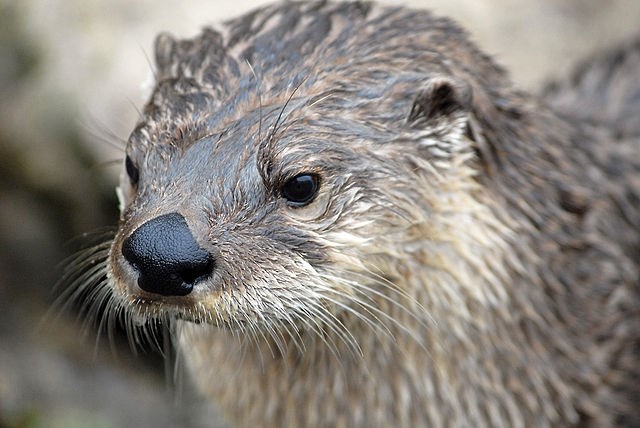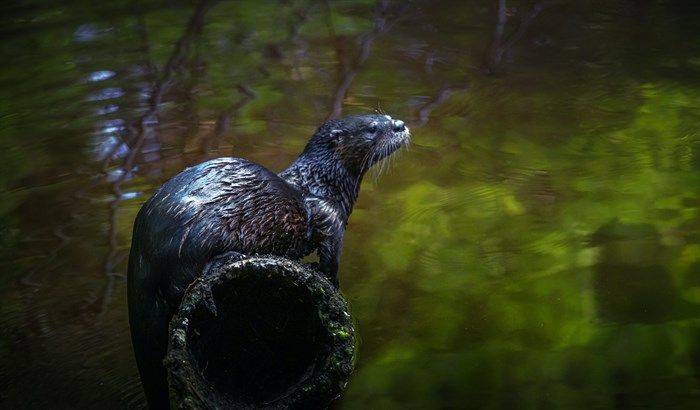
A North American river otter is pictured in this Wikimedia Commons photo.
Image Credit: WIKIMEDIA COMMONS/Chris Paul
January 01, 2024 - 6:00 PM
They may be cute and fluffy on the outside, but river otters could be the Okanagan's biggest mischief-maker.
Unsurprisingly, river otters make their homes in the rivers, creeks and lakes of the Okanagan and won’t be found very far upland, Stewardship Biologist for the Okanagan Similkameen Stewardship, Lia McKinnon, told iNFOnews.ca.
They require burrows to rear and birth their young, which they either find in the hollows beneath tree stumps or steal from their beaver neighbours.
River otters are easily distinguishable from their sea otter counterparts. They have a dark face and long tail in proportion to their bodies. They are also comfortable on land, unlike their ocean cousins.
However, like most other otters, river otters are known for their bad behaviour.
“They're mustelids, so they're part of the weasel family,” McKinnon said. “And they're all kind of little terrors.”
River otters often play together, but sometimes their interactions can get aggressive.
According to McKinnon, otters in South America have terrorized crocodiles and caimans that come too close to their territory.
“I don't know if they think it's fun, or if they want to get them out of their portion of river, or what their end game is. But, they can be pretty nasty,” she said.
In the Penticton channel, river otters have even been reported attacking dogs swimming in the water.

A photo of a river otter taken by Ray Bilcliff.
Image Credit: Pexels.com
Despite their cute exterior, river otters are intimidating. They can grow to over a metre in length and are very agile and adept swimmers. However, as far as McKinnon is aware, none have been reported attacking humans.
The same can’t be said for the fish, aquatic creatures, birds and mammals that make up an otter’s diet.
River otters are opportunistic predators, McKinnon said, and although their favourite catches are slow moving bottom fish, they’ve been known to prey on much bigger animals.
“They're known to eat amphibians (and) they'll sometimes take birds,” McKinnon said. “Generally, when ducks are moulting and they can't fly as well the river otters will be able to get them.”
It’s even up for debate whether river otters eat muskrat and beavers.
“There haven't really been studies that have shown that they're eating a lot of beavers,” she said. “They do eat some beavers, and most of that's from looking at their feces.”
River otters either live alone or in small social groups, usually made up of an adult female and her young.
The young, called kits, will stay with their mother for at least a full year. When their mother becomes pregnant again she will chase her older litter off her territory. The young will stay together for a while until they figure out how to survive on their own, McKinnon said.
Adult females can give birth to between one and five kits per year and in recent years, the species has made a resurgence in the Okanagan, although they might be hard to spot because of their mostly nocturnal activities and shy and reclusive nature.
River otters stay active during the winter and are able to keep warm with their incredibly dense coats, McKinnon explained.
According to the Okanagan Similkameen Stewardship Facebook page, a river otter’s fur is made of two layers. The first is a layer of fine insulating hairs. On top of that are scaly hollow hairs that interlock to create a water resistant barrier.
“This fur is extremely dense, with over 350,000 hairs per square inch. By comparison, the average pet cat has just 60,000 hairs per square inch,” the organization wrote. “Otter fur is also very oily which means it repels water as they swim so they don't get soaked.”
During the winter, if the ice is thin enough, river otters will break air holes in the ice to breathe.
“They'll try and maintain those holes in some areas,” McKinnon said. “Sometimes they'll push holes through the beaver dams in the winter to let a little bit of water out and then they'll try and create an airspace under the ice, which helps them to be able to stay active and forage in the water in the winter. Other than that, you'll often find them in moving water that stays ice free.”
Have you seen any river otters? We'd to share photos if you have them. Send them to news@infonews.ca.
More information about the Okanagan Similkameen Stewardship can be found by following the link here.
To contact a reporter for this story, email Georgina Whitehouse or call 250-864-7494 or email the editor. You can also submit photos, videos or news tips to the newsroom and be entered to win a monthly prize draw.
We welcome your comments and opinions on our stories but play nice. We won't censor or delete comments unless they contain off-topic statements or links, unnecessary vulgarity, false facts, spam or obviously fake profiles. If you have any concerns about what you see in comments, email the editor in the link above. SUBSCRIBE to our awesome newsletter here.
News from © iNFOnews, 2024